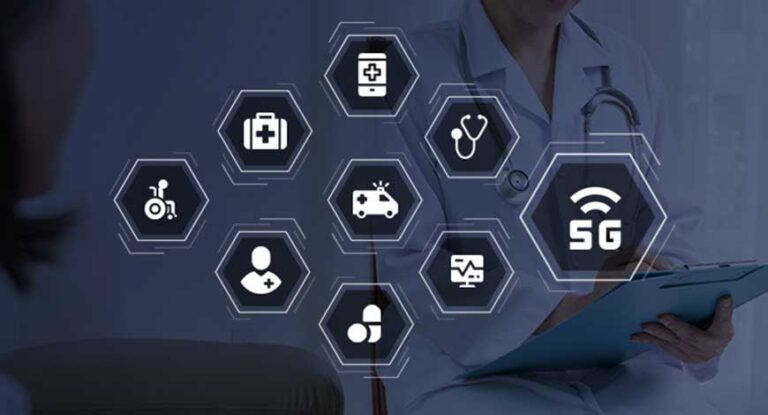The rise of 5G represents a new era in mobile technology, with the potential to accelerate the digital transformation of industries through a range of innovative services, technologies and ecosystems. One area poised to see significant change is healthcare, where the combination of cutting-edge technology and medical expertise will open up unprecedented possibilities.
One of the most promising uses of 5G in healthcare is providing specialized surgical care to individuals who are hard-to-reach treatment, and earlier this year, live robotic telesurgery made possible by 5G connectivity enabled a breakthrough in medical technology.
The operation, which took place more than 10,000 kilometers away from Florida to Dubai, demonstrated the incredible capabilities of 5G. The success of this remote procedure was made possible by the skills of the robotic surgeon and the high-speed, low-latency connectivity provided by 5G technology.
This groundbreaking remote surgery demonstrates the potential for advanced technology to enable equitable access to healthcare, regardless of geographic barriers. In areas where surgical expertise is limited, remote surgery has the potential to be a critical tool to improve patient outcomes and save lives.
Beyond remote surgery, 5G will enable a wide range of healthcare applications, including remote patient monitoring, integrated data networks, real-time image analysis, and remote surgical assistance.
For example, hospitals can equip patients with 5G-connected devices for continuous monitoring. By partnering with communications service providers and IoT healthcare providers, hospitals can secure dedicated network slices with edge storage, processing, and AI capabilities to analyze patients’ vital signs in real time. Offering guaranteed throughput, ultra-fast speeds, and near-zero latency, these dedicated network slices pave the way for live health monitoring, telemedicine, and remote surgery, revolutionizing patient care.
The benefits of 5G in healthcare are already clear. Hospitals are seeing improvements in patient care, including enhanced pre-operative planning, faster imaging, and scalable hardware solutions linked to cloud systems. The use of 5G is also improving training and education for healthcare workers, improving the overall patient experience.
One notable example of 5G’s potential in healthcare comes from Singapore’s National University Health System (NUHS), which has developed AI software compatible with Microsoft’s HoloLens 2 AR headset. The technology helps detect veins in patients, a task that can be difficult if veins are hard to locate.
In this process, a medical professional places a sticker on the patient’s arm, which software identifies and guides the AR headset to locate the vein. This method relies on the absorption of infrared light by blood vessels, freeing up medical professionals’ hands and making procedures like drawing blood more efficient.
NUHS has also deployed indoor 5G networks in several operating theatres and wards, and is testing the use of HoloLens 2 for pre-operative planning. This 5G-enabled “holo-medicine” will enable surgeons to visualise patients’ organs in high-resolution 3D with no delay, significantly improving the planning and execution of surgical procedures.
Surgeons will be able to overlay a 3D hologram of the patient’s brain onto their field of vision during surgery, allowing for more precise and efficient surgery. With a 5G connection, these holographic streams will be smooth and lag-free, better than 4G or Wi-Fi.
Faced with increasing data demands from new devices and applications, healthcare organizations are leveraging edge architectures to bring computing power closer to hospitals and centralize data. Today, hospital data is often siloed, making it difficult to share diagnostic results such as MRI scans and echocardiograms, which can lead to misdiagnoses.
Robust connectivity is essential to transforming healthcare. The foundation of this digital infrastructure is high-performance 5G connectivity and cloud-based solutions that enable seamless data sharing between medical professionals.
Going forward, the future of healthcare will depend on the marriage of technological innovation and medical expertise. As new devices emerge and place ever-increasing data demands on existing infrastructure, healthcare application organizations are turning to edge architectures to centralize data while bringing computing power closer to hospitals.
Data is often siloed in hospitals around the world, and difficulties sharing diagnostic results like MRI scans and echocardiograms can mean patients go undiagnosed. To completely transform healthcare, high-performance connectivity and cloud software that allows for easy data sharing between specialists will be essential components of this new digital infrastructure.
The coming months and years will be crucial in ensuring medical technology advancements are effective, ethically sound and technologically feasible. The convergence of 5G and healthcare offers an opportunity to overcome traditional barriers and drive a new era of medical innovation that enhances patient care, improves outcomes and makes healthcare more accessible and efficient than ever before. Vietnam Investment Review



